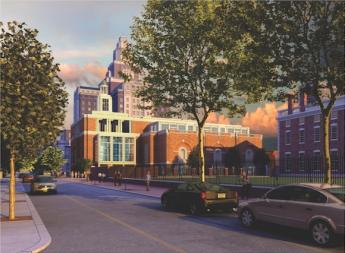Related Topics
Religious Philadelphia
William Penn wanted a colony with religious freedom. A considerable number, if not the majority, of American religious denominations were founded in this city. The main misconception about religious Philadelphia is that it is Quaker-dominated. But the broader misconception is that it is not Quaker-dominated.
The British Attack Philadelphia
Fighting in the Revolutionary War lasted eight years; for two years (June 1776 to June 1778) Philadelphia was the main military objective of the British.
Historical Preservation
The 20% federal tax credit for historic preservation is said to have been the special pet of Senator Lugar of Indiana. Much of the recent transformation of Philadelphia's downtown is attributed to this incentive.
Revolutionary Philadelphia's Patriots
All kinds of people were patriots in 1776, and many of them were all mixed up about what was going on and how they stood. Hotheads in the London Coffee House stirred up about an inoffensive Tea Act, Scotch-Irish come here to escape the British Crown, the local artisan class and the local smuggler class, unexpectedly prospering under non-importation, and the local gentry -- offended to be denied seats in Parliament like other Englishmen. Pennsylvania wavered until Ben Franklin stepped forward with a plan.
Touring Philadelphia's Western Regions
Philadelpia County had two hundred farms in 1950, but is now thickly settled in all directions. Western regions along the Schuylkill are still spread out somewhat; with many historic estates.
The Main Line
Like all cities, Philadelphia is filling in and choking up with subdivisions and development, in all directions from the center. The last place to fill up is the Welsh Barony, a tip of which can be said to extend all the way in town to the Art Museum.
George Washington in Philadelphia
Philadelphia remains slightly miffed that Washington was so enthusiastic about moving the nation's capital next to his home on the Potomac. The fact remains that the era of Washington's eminence was Philadelphia's era; for thirty years Washington and Philadelphia dominated affairs.
Right Angle Club: 2013
Reflections about the 91st year of the Club's existence. Delivered for the annual President's dinner at The Philadelphia Club, January 17, 2014.
George Ross Fisher, scribe.
Museum of the American Revolution
The Right Angle Club of Philadelphia was recently pleased to be visited by Michael C. Quinn, the President, and CEO of the forthcoming Museum of the American Revolution, which will be built at Third and Chestnut Streets, on the site of the former Visitors Center. Mr. Quinn comes to us from the Mt. Vernon and James Madison Museums in Virginia and expects to spend another three years getting the new Museum built and established. It's also expected to cost about $150 million, so look for something really special. The great majority of the required money is expected to come from Philadelphia and surrounding territory, led by a challenge grant from Gerry Lendfest of $40 million.
The collection of Valley Forge and related Revolutionary artifacts was begun by Herbert Burk, an Episcopal rector in Norristown, Pennsylvania, and the son of another Episcopal rector of Clarksboro, New Jersey, and who graduated from the University of Pennsylvania toward the end of the Nineteenth century. The Valley Forge area was pretty well deserted at that time, and the local bishop expressed doubt that it could support both an Episcopal and a Baptist church, particularly since an earlier rector named Guthrie had attempted it and finally disappeared. Reverend Burk, however, was fired with the vision of Washington kneeling in the snow, and highly scornful of doubters who insisted on seeing his footprints in the snow before they would accept it. These were the days just after the German historian Leopold von Ranke had started a movement of great enthusiasm among historians for documents to prove almost anything calling itself history, so there was more than the usual amount of harumphing among academics about authenticity, which Burk dismissed with scorn. Since his second wife was a Stroud, there may have been social issues as well. About all, we really know of George Washington's religious beliefs was that he regularly went to Christ Church and sat in Martha Washington's pew; but he resolutely refused to take Communion. It sounds to some of us as though he was more of a politician than a theologian. But the Museum now has picked up successor enthusiasts, determined to make the Museum a success; so let's let that religion matter drop.

|
| Museum of the American Revolution |
The old visitors center was given a bell by Queen Elizabeth II, who brought it over on the royal yacht and gave a memorable speech at its installation. The deed to the property does not include the bell, and its future is presently uncertain. However, the building will be torn down and replaced by a much larger structure, intended to house many rooms and a tour lasting hours, to show off Washington's military tent and similar artifacts of the low point of the Revolution, when it rested with the personal character of a few founding fathers, to preserve the drive and idealism of the freezing, starving troops. It's a tall challenge for Mike Quinn to carry it off with the right mixture of showmanship and concern for accuracy. After all, no good story is improved by exaggeration.
Originally published: Friday, December 14, 2012; most-recently modified: Friday, May 24, 2019